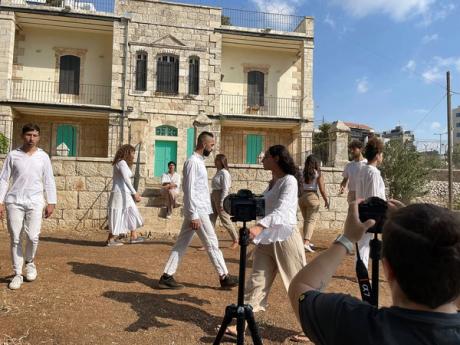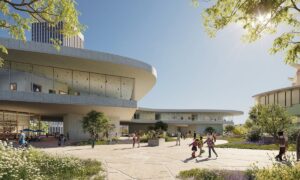[ad_1]

Exactly a month after the selection committee chose the artist Ruth Patir for the Israeli pavilion at the 60th Venice Biennale, Hamas carried out its atrocities in Israel, killing 1,200 people and taking 240 people hostage.For two weeks after 7 October, “we were paralysed, frozen in fear and shock”, says Mira Lapidot, the chief curator of the Tel Aviv Museum of Art, and the co-curator of the pavilion, with Tamar Margalit. “But then we decided we had to go ahead,” Lapidot says. “Art is not a luxury, even if it sometimes feels that way in times of war and horror. It is central to building understanding between people.”The Biennale often mirrors war and geopolitical tensions—in part because of its century-old structure, long criticised as anachronistic, with national pavilions. Before the last Biennale, the artists and curator chosen for the Russian pavilion withdrew after the invasion of Ukraine. In an era when war is a daily reality for millions of people, it is unsurprising that conflict looks set to be a recurring theme in this edition, too.Israel’s Modernist pavilion at the VeniceBiennale, which first opened in 1952 Riccardo Bianchini/Alamy Stock PhotoThe Israeli reprisals in Gaza had claimed more than 30,000 lives by the end of February, according to Hamas health ministry figures. The devastation has extended to heritage sites and museums: as of 21 February, Unesco had verified damage to five religious sites in Gaza, ten buildings of historical and artistic interest, two depositories of moveable cultural property, one monument, one museum and three archaeological sites.The conflict between Israel and Hamas has created rifts in the art world further afield—particularly in Germany, where several exhibitions have been cancelled because artists or curators made comments viewed by institutions as antisemitic or anti-Israel.The Israeli pavilion at the Biennale has already been the target of an open letter calling for the exclusion of Israel from the Biennale signed by thousands of artists and cultural workers. The letter was issued at the end of February by a group called the Art Not Genocide Alliance. Italy’s culture minister, Gennaro Sangiuliano, called it “shameful” and expressed “deepest solidarity and closeness” to the state of Israel, its artists and its citizens. The Biennale said in a statement that “all countries recognised by the Italian Republic may autonomously request to participate” and it would not heed “any petition or call to exclude the participation of Israel or Iran”.Lapidot says she is aware that protests at the Israeli pavilion are a risk. “Yes, we are Israelis, but we do not represent our government,” she says, adding that she hopes the pavilion will remind visitors that “Israel is more than [prime minister] Netanyahu on TV”. But more than anything, she says, “we are hoping desperately that the situation with the hostages and in Gaza will be alleviated soon”.A still from Daniil Revkovskyi and Andrii Rachynskyi’s Civilians. Invasion chronicling destruction in Ukraine Courtesy of the artistsRuth Patir’s exhibition Motherland consists of video installations that animate archaeological artefacts—female figurines dating from 800 to 600BC. “Forlorn women of a past civilisation, the figurines reach us across time, whether intact, or more often broken—remnants of bloody feuds,” the press release says.Palestinians rebuffedWhile Israel has chosen to forge ahead with its national pavilion, aspiring Palestinian participants say they have been excluded from the Biennale. Faisal Saleh, the founder of the Palestine Museum US in Woodbridge, Connecticut, started a petition after his proposal for the Collateral Events section, featuring 23 artists including some from Gaza, was rejected.In his petition, which had collected almost 22,000 signatures in February, Saleh wrote: “The exclusion of Palestinian voices contributes to an incomplete picture that undermines efforts towards understanding and peace.”Palestinian artists will still be represented in Venice: one of the Collateral Events projects, South West Bank—Landworks, Collective Action and Sound, is organised by Artists + Allies x Hebron in cooperation with Dar Jacir for Art and Research, which is based in Bethlehem.One of the exhibitions in this event, Freedom Boat, will travel through the Grand Canal and around the Giardini on the opening days of the Biennale, according to a press release. Presented by a UK-based group, Artists Against Apartheid, artists on board “will lead readings, performances and other acts in the name of Palestinian solidarity”. Among the contributors is Issa Amro, a Palestinian activist.South West Bank also includes photographs of olive trees, some more than 1,000 years old, taken by Adam Broomberg and Rafael Gonzalez in the occupied territories. The trees, “untouched for centuries, suddenly feel so precarious”, the release says.Ongoing and future conflictsRussia is once again a no-show at Venice. Visitors could be forgiven for thinking that Ukraine’s pavilion presentation, Net Making, describes a homely handicraft—in fact it refers to the collective weaving of camouflage nets for use in the ongoing war. The pavilion will address “the topic of otherness through personal experiences of war, emigration, and assimilation in new societies”, according to a statement.Among the works on show, Civilians. Invasion (2023), a film by Daniil Revkovskyi and Andrii Rachynskyi, tells the story of the first days of the Russian invasion through the eyes of survivors, and is assembled from videos they found online. The artists describe it as a “horror encyclopedia, capturing the harrowing experiences people endure during a full-scale invasion”.One geopolitical hotspot that seizesfewer headlines than Gaza or Israel is devoting its entire exhibition to war. Everyday War is the title of Taiwan’s contribution to this Biennale, a solo exhibition by Yuan Goang-Ming. A new video by the artist imagines a devastating attack in Yuan’s own home. “Glass shatters loudly, then warplanes fly in one after the other, destroying objects in the room,” according to a press release. “Finally, allthe aircraft annihilate one another, and the whole house is left a ruin in the aftermath of battle.”Yuan’s work “allows people to step into the psyche of what it means to live in Taiwan,” says Abby Chen, the curator of the exhibition. “Yes, it could be ten times worse than we imagine. So the artist presents that anxiety, but at the same time, I think he gives us a glimpse of a way out.”Treated by China as a breakaway region that must be unified with its vast neighbour, democratic Taiwan has in recent months come under increasing military, economic and diplomatic pressure. Another of Yuan’s works on show in Venice, Everyday Maneuver (2018) shows the mandatory annual air-raid drills in which all Taiwanese must take part.“Every year the artist and his family need to take shelter,” Chen says. “But you will see that the artwork shows order. It doesn’t show chaos or fear. This is something we actually don’t see that often these days—the authorities and civilians cooperating. There’s this very obvious shared understanding of being in something together.”
[ad_2]




















